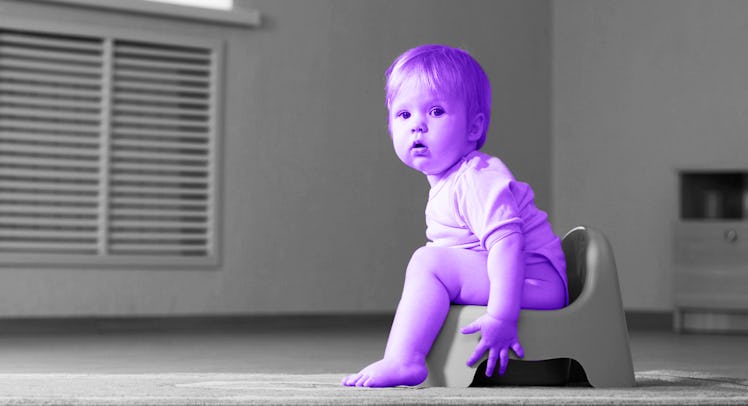How to Use Elimination Communication to Potty Train a Child Early
Keeping a child close is key to learning when they need to poop or pee.

Elimination communication, often abbreviated EC, is a method of helping a child learn their body’s cues in order to make potty training happen more easily and possibly earlier. How early? Parents who are successful with elimination communication are often able to potty train children before they are 1-year-old. Before you sing “Hallelujah!” and dive in, there are caveats: EC is by no means an easy or laid-back way to potty train a child. It requires constant closeness, attention, vigilance, and getting real intimate with your kid’s bowel movements. Yeah, it’s not for everyone.
The best way to minimize failure (or disappointment) with elimination communication is to realize this process is not really about the end game. “Effective EC may not always lead to earlier potty training because the same issues of control and readiness are at play with potty training,” says Dr. Courtney Bolton, a child development expert and Chief Clinical Officer at Weldon Parenting. Which is to say, if a baby isn’t quite ready to potty train, they will resist. But elimination communication still paves the road for potty training and more, helping to build a strong foundation of body awareness for young children.
Elimination communication is often the default potty training method in cultures where parental closeness exists from infancy and is the norm. In Asian countries, such as Vietnam and China, children often spend their first months completely undiapered. Mothers watch the child for signs of peeing and pooping, and once they learn these signs they begin conditioning the child by making a sound before they potty. This sound becomes a trigger. Soon babies can be placed over a toilet and eliminate upon hearing the sound.
Since understanding a child’s cue and timing is crucial to the success of elimination communication potty training, parents must have their baby close at all times. “The primary reason this works for parents in countries where babywearing is prevalent is that their little ones are typically ‘skin to skin,’ ” says Dr. Bolton. “It’s certainly possible to use EC in Western countries, but it usually happens later for a number of reasons, including divided attention, being distanced from children who more often sleep in cribs, ride in car seats, etc.”
While it is not necessary to wear a baby constantly, it can help a parent understand what kind of behaviors a baby engages in before pooping or peeing and what the timing of their elimination looks like. For the youngest babies, the signs can be very subtle, so sussing them out requires undivided attention. Meaning? “Put down the cellphone and really be focused on your child,” says Bolton. “What does he/she do to let you know it’s time to go? Some will become rigid as they prepare to push or stretch out their legs, others grunt. Knowing the signs that your little one is ready, is key to EC.”
More than observation, parents can also consider the timing of elimination. These rates can be very regular for babies. Infants may not go longer than 20 minutes without eliminating. As they get older the time will increase and likely coincide with when they’ve eaten or slept.
“If there’s a time that your child relieves themselves, then make sure at that point to be watching — that’s how we pick up on those subtler cues,” Bolton explains. “Of course, depending on what babies are fed, potty times will vary. Breastfed babies, for example, can go a few days without a BM, but they will urinate.”
Once the cues and timing are understood, parents can begin signaling a child by giving them cues as they place them over a potty during elimination. The cues are completely personal and there is no one sound that works better than others. Older children may even benefit from visual cues like a sign language “T” for toilet. Eventually, the child will associate the signal with the elimination and may even use the signal themselves to indicate they need to potty.
But Bolton stresses that success at elimination communication is not having a baby the potty trains. Success is having a parent in tune with their kid and a kid in tune with themselves. Who knew potty training, of all things, would bring you and your kid closer?
Elimination Communication Potty Training: A Cheat Sheet of Cues
Potty training by elimination communication is all about picking up on the cues. While all cues are unique, here are some of the most common ones.
- A sound. Rumbling in the belly? That could be the lead-up to an elimination. Again, this subtle sort of sound is only found if you keep them close.
- A red face. This is a common sign of a coming bowel movement, recognizable right away.
- A look. A more subtle change in face, especially among infants, can mean your kid is eliminating. To learn whether that raised brow, smile, or look of consternation is a sign, you need to keep it close.
- A grab. It’s not uncommon for a kid to touch their genitals or try to stick their hands under their diapers when eliminating. File this under a more obvious sign.
- Something else. No two kids will have the same elimination signs. This is why you watch them like a hawk, learn the cues, and work from there
This article was originally published on